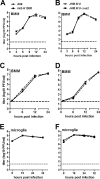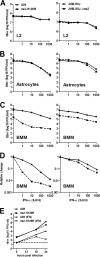Cell-type-specific type I interferon antagonism influences organ tropism of murine coronavirus
- PMID: 21752905
- PMCID: PMC3196400
- DOI: 10.1128/JVI.05075-11
Cell-type-specific type I interferon antagonism influences organ tropism of murine coronavirus
Abstract
Previous studies have demonstrated that mouse hepatitis virus (MHV) hepatotropism is determined largely by postentry events rather than by availability of the viral receptor. In addition, mutation of MHV nonstructural protein 2 (ns2) abrogates the ability of the virus to replicate in the liver and induce hepatitis but does not affect replication in the central nervous system (CNS). Here we show that replication of ns2 mutant viruses is attenuated in bone marrow-derived macrophages (BMM) generated from wild-type (wt) mice but not in L2 fibroblasts, primary astrocytes, or BMM generated from type I interferon receptor-deficient (IFNAR(-/-)) mice. In addition, ns2 mutants are more sensitive than wt virus to pretreatment of BMM, but not L2 fibroblasts or primary astrocytes, with alpha/beta interferon (IFN-α/β). The ns2 mutants induced similar levels of IFN-α/β in wt and IFNAR(-/-) BMM, indicating that ns2 expression has no effect on the induction of IFN but rather that it antagonizes a later step in IFN signaling. Consistent with these in vitro data, the virulence of ns2 mutants increased to near that of wt virus after depletion of macrophages in vivo. These data imply that the ability of MHV to replicate in macrophages is a prerequisite for replication in the liver and induction of hepatitis but not for replication or disease in the CNS, underscoring the importance of IFN signaling in macrophages in vivo for protection of the host from hepatitis. Our results further support the notion that viral tissue tropism is determined in part by postentry events, including the early type I interferon response.
Figures








Similar articles
-
Murine coronavirus mouse hepatitis virus is recognized by MDA5 and induces type I interferon in brain macrophages/microglia.J Virol. 2008 Oct;82(20):9829-38. doi: 10.1128/JVI.01199-08. Epub 2008 Jul 30. J Virol. 2008. PMID: 18667505 Free PMC article.
-
Selective Packaging in Murine Coronavirus Promotes Virulence by Limiting Type I Interferon Responses.mBio. 2018 May 1;9(3):e00272-18. doi: 10.1128/mBio.00272-18. mBio. 2018. PMID: 29717007 Free PMC article.
-
Activation of RNase L by Murine Coronavirus in Myeloid Cells Is Dependent on Basal Oas Gene Expression and Independent of Virus-Induced Interferon.J Virol. 2016 Jan 6;90(6):3160-72. doi: 10.1128/JVI.03036-15. J Virol. 2016. PMID: 26739051 Free PMC article.
-
[Mouse hepatitis virus].Schweiz Arch Tierheilkd. 1996;138(4):183-8. Schweiz Arch Tierheilkd. 1996. PMID: 8677422 Review. German.
-
Pathogenesis of murine coronavirus in the central nervous system.J Neuroimmune Pharmacol. 2010 Sep;5(3):336-54. doi: 10.1007/s11481-010-9202-2. Epub 2010 Apr 6. J Neuroimmune Pharmacol. 2010. PMID: 20369302 Free PMC article. Review.
Cited by
-
STAT2-dependent restriction of Zika virus by human macrophages but not dendritic cells.Emerg Microbes Infect. 2021 Dec;10(1):1024-1037. doi: 10.1080/22221751.2021.1929503. Emerg Microbes Infect. 2021. PMID: 33979266 Free PMC article.
-
Intercellular Communication Is Key for Protective IFNα/β Signaling During Viral Central Nervous System Infection.Viral Immunol. 2019 Jan/Feb;32(1):1-6. doi: 10.1089/vim.2018.0101. Epub 2018 Sep 15. Viral Immunol. 2019. PMID: 30222502 Free PMC article. Review.
-
Viral phosphodiesterases that antagonize double-stranded RNA signaling to RNase L by degrading 2-5A.J Interferon Cytokine Res. 2014 Jun;34(6):455-63. doi: 10.1089/jir.2014.0007. J Interferon Cytokine Res. 2014. PMID: 24905202 Free PMC article. Review.
-
Toll-like receptor-2 exacerbates murine acute viral hepatitis.Immunology. 2016 Oct;149(2):204-24. doi: 10.1111/imm.12627. Epub 2016 Aug 10. Immunology. 2016. PMID: 27273587 Free PMC article.
-
Possible Therapeutic Intervention Strategies for COVID-19 by Manipulating the Cellular Proteostasis Network.Adv Exp Med Biol. 2021;1352:125-147. doi: 10.1007/978-3-030-85109-5_8. Adv Exp Med Biol. 2021. PMID: 35132598
References
-
- Caamano J., Alexander J., Craig L., Bravo R., Hunter C. A. 1999. The NF-kappa B family member RelB is required for innate and adaptive immunity to Toxoplasma gondii. J. Immunol. 163:4453–4461 - PubMed
-
- Cervantes-Barragan L., et al. 2009. Type I IFN-mediated protection of macrophages and dendritic cells secures control of murine coronavirus infection. J. Immunol. 182:1099–1106 - PubMed
Publication types
MeSH terms
Substances
Grants and funding
LinkOut - more resources
Full Text Sources

